There is a certain time in every angler’s life when they decide to push a little further in pursuit of trophy fish and explore the expanse of bluewater beyond the bays and estuaries. For me, chasing longtail tuna and spotted mackerel in the Moreton Bay region was the call I had to answer.
I always wondered what other pelagics patrolled the waters of the deep blue but I never knew if my boat was large enough to be capable of getting out there. I’ve always fished from a 5m boat, which has proved to be extremely manageable and comfortable in my experience. Rest assured, any boat from 4.5m upwards is capable of experiencing offshore conditions. It all comes down to understanding your boat, how it rides, and planning the weather and tides on the day.
Safety is key, and the most important thing you need to consider before you start your offshore adventure. Flares and EPIRB are essential, but ensuring that your boat is seaworthy takes precedence over anything else. Take your boat in for a service or check-up regularly. Keep in mind something as simple as an automatic bilge – a must on any offshore tour. Once you’re confident using your boat and motor, you can start to plan your trip. I run the same routine every time, to guard against any unwelcome surprises. Use the run-in tide so the swell isn’t standing up, ensure you only come up against low swell under 2m, and don’t speed. The ocean is unpredictable, and can turn on you in an instant – make sure you don’t do more than 15knots. If I can’t expect or achieve these conditions, I stick to the Bay. No fish is worth risking your life – or even your boat.
Most fishers will have a friend who regularly fishes offshore. Follow the more experienced boaties out through the bar to gain an understanding of the speed and path that is safe and reliable to head out along. As you head out place a mark on your GPS every 50m. This will leave you a bread trail for the way home.
Once you’re out, the big question is, where do I start fishing? The ocean is a huge place, and can overwhelm and discourage new comers if they can’t put fish in the boat. To combat this you need to have a game plan. Fish to the season by understanding what species are firing at the time. For example, if you want to chase Spanish mackerel, winter is the perfect time as the really big models are hanging around. Know what time peak bites occur – midway through the tides when the bait is most concentrated on pressure edges.
Look to your sounders to find defined edges or alternatively, areas that hold bait. An example of this is Boat Rock off Stradbroke Island. It’s roughly 35km from Cleveland boat ramp, which will give you a round trip of around 85km including fishing. I know my boat – a Signature 543SF with a 140 Suzuki – runs on 2.5 km/L. This means I will need at least 34L to get me through the morning. The worse thing you can do is leave yourself with just the right amount of fuel. I’ve learnt a few hard lessons over the years, leaving fish on the chew because I didn’t put in enough fuel for my day.
The excitement of fishing open water is not knowing what the day will bring, whether you are casting stick baits for mackerel and instead encountering rogue marlin, or starting your journey home to find a school of yellowfin busting the surface. I have a 180L fuel tank and will never have less than 150L when I head out. You never know what you are going to come across.
Having a small boat shouldn’t limit you, it just means you have to be a little bit smarter about where you fish and the conditions you are fishing. You really don’t have to travel far to catch quality fish offshore. Ensure you stick to the same principles as if you were fishing the bay. For snapper, early morning flicking plastics around shallow structure is effective. As the morning goes on, work your way out deeper, and always keep an eye on your sounder to find the bait to lead you to the fish. When chasing pelagics, look for pinnacles or ledges that hold bait and always keep an eye out for birds as they are looking for the same thing as you.
You need to keep pushing the boundaries in your boat and fishing the Australian coastline, as it is home to some of the world’s best fishing. There is no reason why a 5m boat isn’t capable of getting amongst it. Plan your trips in local open waters and estimate how far you think you might travel and how much fuel you might use – before you leave home. A handy tip is to fill your boat up before you head out and fill it up when you get home to see how close your fuel consumption was to what you estimated.
The bunker group out of 1770 is only 70km out, which will give you a round trip of 160km. With all this considered, you really only need around 70L to fish some of the most amazing waters you could ever dream of and only a few hours north of Brisbane.
Be confident in your fishing and ability to try new things. Keep an eye on weather patterns and know when the sea breeze is expected to kick in so you’re not travelling home in 15 knots.
Reads: 1814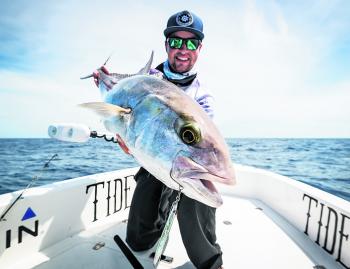
The author with a stunning amberjack caught from a 5m boat offshore. How good is that? (Photo courtesy of Andrew Mckinstray)
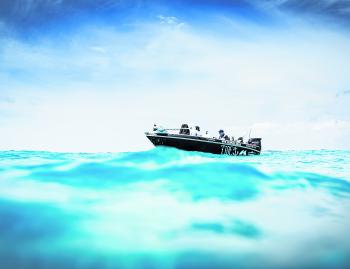
Having a smaller boat only means you have to be more strategic about fishing offshore. (Photo courtesy of Andrew Mckinstray)
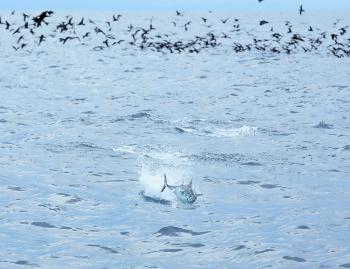
Give the estuaries a break, get offshore and into some tuna action. (Photo courtesy of Andrew Mckinstray)

The Tide boys whipping up some pelagics offshore with a solid kingie and another wicked amberjack. (Photo courtesy of Andrew Mckinstray)
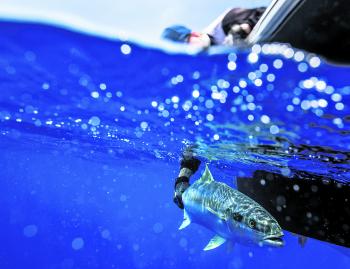
A 5m boat is just as capable of getting to the area you need to be to catch and release a big kingfish. (Photo courtesy of Andrew Mckinstray)
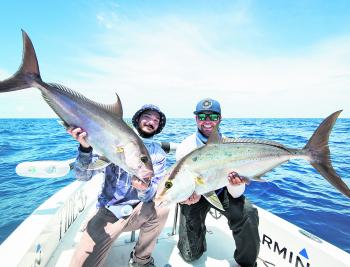
All smiles for Andy Mckinstray and the author, on a sunny day offshore catching huge fish. It doesn’t get better than this. (Photo courtesy of Andrew Mckinstray)




